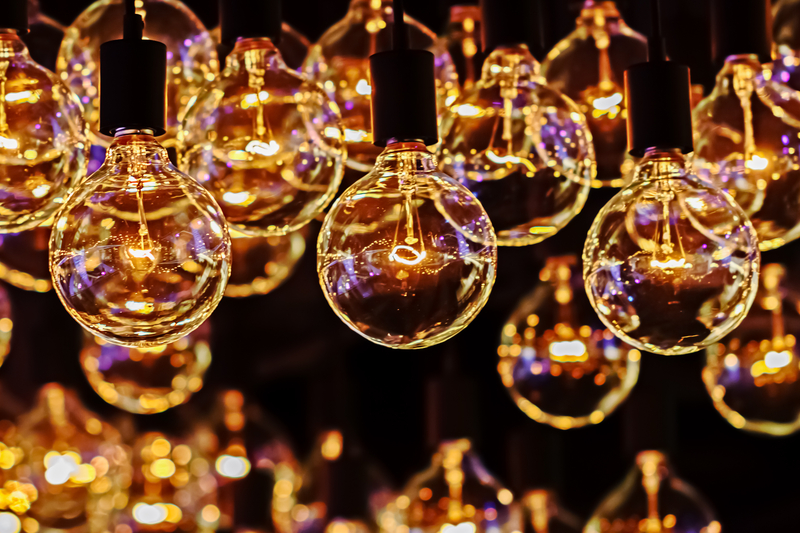Lighting can play a big part in your room’s overall design. Whether in the kitchen, living room, bedroom, or even the mudroom, lighting matters. Factors such as what the room is used for, how much natural light it receives, and what kind of lighting types you’re working with can all play a role in setting the scene. While there are plenty of ways to strike the right balance, there are also a handful of ways lighting can go wrong. Here are the mistakes to avoid when it comes to lighting, plus how to fix them.
1. You Aren’t Paying Attention to Wattage
Each light fixture in your home has a recommended wattage that you should not exceed. Wattage measures the amount of energy the bulb emits—it doesn’t affect how bright or dim your light is. Selecting the right wattage for your fixture not only ensures you’re making an energy-efficient choice, but a safe one, too. If you select a bulb that is too high in wattage, it can cause damage to the fixture and lead to overheating with an increased potential for an electrical fire. Play it safe and always pay attention to wattage when outfitting your fixtures.
2. You Chose the Wrong Color Temperature
There are a variety of factors to look for when selecting the right lightbulbs for your fixtures. One of these is color temperature. It’s best to think about the function of the space when determining the right bulb temperature. For bedrooms, living rooms, and dining rooms (places where you want more ambience), warmer light is best. For spaces like the kitchen, home office, bathroom, or laundry room, cooler light will help create a more energized feeling.
Soft White vs. Warm White vs. Daylight Bulbs: How to Choose the Right Lighting
3. Your Task-Oriented Spaces Are Too Dark
The brightness of your bulbs isn’t measured by the color temperature or even wattage but, instead, by lumens—and it’s just one more thing to consider when you’re selecting the right bulb for your light source. Particularly in spaces that are task-oriented like kitchens, bathrooms, and offices, it’s important to make sure there’s plenty of bright light. Similarly, you’ll want to make sure you don’t go too bright in spaces like bedrooms, living rooms, and other leisure spaces. But what happens if you want a more custom feel? That’s where a dimmer comes in.
4. You Didn’t Install a Dimmer
So you chose the right wattage, paid attention to the color temperature, and also made sure to select the right amount of light for each space, but something is still missing. It might just be a dimmer. For rooms where you might want a range of light (a brighter, more energetic look during the day, and dimmer, more ambient light in the evening) a dimmer can be just the ticket. You’ll likely find you don’t need to install a dimmer in every room, but it can be helpful in spaces like dining rooms, living rooms, and bedrooms.
5. You Chose the Wrong Scale for Your Fixture
It might be tempting to commit to a too-small fixture when you’ve found the perfect style for your space. However, it’s best to keep looking. A light fixture with the wrong scale can quickly become an unsightly focal point that makes the space feel off. Think about the height of your ceilings if you’re selecting an overhead fixture or the furnishing your fixture will sit upon if you’re selecting a lamp. Surrounding decor, the space’s design style, and more can all be factors that affect the desired scale for your light source.
While secondary light fixture scale should also be considered, it’s the overhead focal point fixtures that require the most attention when determining an ideal size for your space. As a general rule, the length + width (in feet) of the room should equal the diameter of a chandelier in inches.
6. You Used Just One Type of Lighting
Lighting isn’t a one-and-done element. It’s important to use a mix of lamps, overhead lighting, floor lamps, and sconces. Having more than one kind of light source in a room adds character, dimension, and warmth while also allowing flexibility in how you light your space for various occasions. For example, if you’re playing a board game in the living room and want plenty of light, overhead lights can be ideal. But if you’re having a low-key movie night in the same space, a simple lamp or two, or perhaps even dimmed sconces, can create just the right amount of ambient light.
7. You Aren’t Considering Natural Light
Finding the right balance of lighting isn’t all about artificial light. In fact, a lot of it can hinge on the amount of natural light in your space. Playing to natural light—and building your lighting around it—can create the ideal environment. Knowing the time of day when your space is the brightest, which windows are the most impactful for natural light, and determining the corners of your room that light doesn’t quite reach can help you map out your ideal lighting plan.
Patricia Shannon, Better Homes & Gardens
